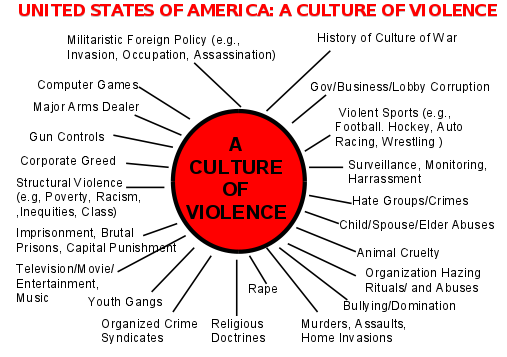USA: A “Culture of Violence”
TRANSCEND MEMBERS, 15 Jul 2024
Anthony J. Marsella, Ph.D. – TRANSCEND Media Service
Originally published on 12 Nov 2012
Charting a “Culture of Violence:” Causes and Consequences
As the immediate emotions of the presidential elections pass — the euphoria and elation of the winners, the grief, despair, anger of the losers — the harsh realities of daily life once again emerge. Among these is the widespread violence that exists in the United States as displayed in Figure 1. As Figure 1 demonstrates, the manifestations and consequences of violent acts are extensive. This suggests the existence of a “culture of violence” that is generated, sustained, and promoted by acts that arise from individual and collective impulse and intent, and that too often find tier tolerance and approval across political, economic, educational, military, and moral policies of institutions.
Regardless of our wishes that this was not the case, the United States of America is a “culture of violence.” The Figure 1 (i.e., chart) offers a quick visual display. It is neither comprehensive nor explanatory, aside from recognizing the reciprocity among the different acts and sources of violence. There is an obvious interaction across the acts displayed in which simple cause-effect relations disappears amidst the complexity. Each act is both a source and consequence. A cultural ecology of violence.
The Omnipresence of Violence
Violence abounds in American society, touching everyone’s life as victim, perpetrator, or anxious observer and witness of the endless violent acts committed locally, nationally, and internationally. Ultimately we are all victims and perpetrators through acts of intention or acts of silence and indifference that support a tolerance of the situation. There is no escape from this reality. How much more violence can we view on TV, how much more violence can we cheer and applaud in entertainment, how much more violence can we experience before we are faced with a constant state of stress, anxiety, anger, and/or moral indifference?
There is a widespread fear, anxiety, and stress that leaves citizens of all ages feelings vulnerable and insecure, awaiting the possibility of violence touching their lives, and bring with it grief and sorrow. It is clear violence is widespread in the world. Every person — regardless of location — is compelled to live with daily reminders of risk and danger. What is distinct about violence in the USA, however, is the existence of a national culture of shared, learned behaviors and meanings transmitted across generations via ethoses, values, attitudes, and ways-of-life that are violent. These inform and guide our institutions resulting in the socialization of a culture of violence.
USA Foreign Policy: Driver of National and Global Violence
The foreign policies and actions of the United States of America over the course of the past 100 years are rooted in intentions to control and dominate international order of nations and cultures. These policies and actions have proven destructive to national and global peace, and have served and empowered the interests of a limited number of individuals and groups. Ultimately, under the guise of protecting “national interests” these policies and actions are major sources, carriers, and promoters of violence nationally and globally. They are asymmetrical and hegemonic in nature, and sustain the status quo in consequence. While all are announced as intentions to bring democracy and freedom, they have too often resulted in occupation, oppression, and repression of human rights. An obvious result — visible in virtually every nation caught in our efforts – is the costly growth of a vast USA network of: (1) military bases and operations, (2) massive fortress embassies/consulates, (3) encampments/prisons, (4) death squads, (5) cultural disintegration and decline.
These policies and actions do not promote cooperation and admirations, rather they encourage instability via reflexive protests, insurrections, rebellions, revolutions, and acts of domestic, state, and international terrorism. Table 1 display the spectrum of USA foreign policy and action choices, options, and alternatives. All nations act in their own interests, The issue, however, is that in a global era, in which the understanding of the causes and consequences of violence and war are now better known, selfish national interests result in direct and indirect opposition. For many nations who feel victimized and humiliated by the USA, revenge is considered just and appropriate. This creates an endless cycle. Who benefits? Table 1 displays a spectrum of USA foreign policy and action practices — they are used as needed.
Table 1: USA Foreign Policy and Actions Choices, Options, Alternatives
- Assassinations/death squads/drones,
- Bounties for info/capture
- Bribery/blackmail/entrapment
- Celebration of national “morality”/necessity of torture
- Collaboration/contracts with universities, scientists, professional organizations
- Contingent “humanitarian” aid
- Contingent foreign aid
- Control UN via vetoes
- Control IMF and World Bank
- Cooperate with foreign nations (e.g., military, intelligence)
- Development of domestic crowd controls (militarization of police)
- Diplomacy
- Drug wars and corruptions
- Disproportionate support of “allies” and enemification of others,
- Establishment of military bases [more than 900 known foreign bases],
- Exportation of popular American culture
- Foreign student/faculty/consultant exchanges
- Fund development of disguised/pseudo-organizations (e.g. Human Ecology Fund)
- Glorification of war, militarism, warrior mentalities
- Hegemonic globalization
- Infiltrate peace and anti-war groups
- Mass surveillance, monitoring, and archiving of data,
- Massive government/private intelligence security agencies/organizations
- Media influence and control
- Military intervention
- Mind control technologies (e.g., drugs, EMR)
- Negotiation/conflict resolution
- Non-Prosecution of connected military, government, civilian law violators/abusers
- Occupation
- Promotion of nationalism/pseudo-patriotism
- Propaganda and promotion of USA exceptionalism,
- Purchase and installation of pro-American leaders and dictators,
- Recruitment of spies, informers, collaborators, agents
- Use surrogate nations and forces
- Use false flags incidents
- Use major philanthropic foundations to influence policy and actions
- Vilification of domestic/international critics.
- Weapons/arms dealer/sales
- Witness protection programs
Closing Remarks
I have published two articles in recent years regarding war and peace. The first article is entitled: “The United States of America: A Culture of War” (Marsella, A.J. [2012]. The United States of America: A “culture of war.” International Journal of Intercultural Research, 35, 714-728. This article documents the long history of war in the United States, and the American cultural ethos that has spawned and nurtured wars. The second article is a please for nonkilling and an end to violence. It is entitled “Nonkilling psychology and lifeism” (Marsella, A.J. (2011). Nonkilling psychology and lifeism. In J. Pim & D. Christie (Eds.) Nonkilling Psychology (pp. 361-378). Honolulu, Hi: Center for Global Non-Violence.). This article calls for humanity to move beyond unbridled national identities to an identity with life itself, the very force that animates our world and universe.
In both of these articles, and in this article, it is clear to me that we are headed for a “dreadful reckoning” (Grieder’s term) if we do not come to an awareness of the many sources and consequences of violence in our lives, particularly the perpetuation of “cultures of violence” that are sources of endless suffering, destruction, and death. The answer resides in the necessity of non-violent activism to prevent violence. This is the timeless answer of every great peacemaker.
_______________________________
 Anthony Marsella, Ph.D., a member of the TRANSCEND Network, is a past president of Psychologists for Social Responsibility, emeritus professor of psychology at the University of Hawaii, and past director of the World Health Organization Psychiatric Research Center in Honolulu. He is known nationally and internationally as a pioneer figure in the study of culture and psychopathology who challenged the ethnocentrism and racial biases of many assumptions, theories, and practices in psychology and psychiatry. In more recent years, he has been writing and lecturing on peace and social justice. He has published 15 edited books, and more than 250 articles, chapters, book reviews, and popular pieces. He can be reached at marsella@hawaii.edu.
Anthony Marsella, Ph.D., a member of the TRANSCEND Network, is a past president of Psychologists for Social Responsibility, emeritus professor of psychology at the University of Hawaii, and past director of the World Health Organization Psychiatric Research Center in Honolulu. He is known nationally and internationally as a pioneer figure in the study of culture and psychopathology who challenged the ethnocentrism and racial biases of many assumptions, theories, and practices in psychology and psychiatry. In more recent years, he has been writing and lecturing on peace and social justice. He has published 15 edited books, and more than 250 articles, chapters, book reviews, and popular pieces. He can be reached at marsella@hawaii.edu.
Tags: Anglo America, Cultural violence, Culture of Violence, Structural violence, USA
This article originally appeared on Transcend Media Service (TMS) on 15 Jul 2024.
Anticopyright: Editorials and articles originated on TMS may be freely reprinted, disseminated, translated and used as background material, provided an acknowledgement and link to the source, TMS: USA: A “Culture of Violence”, is included. Thank you.
If you enjoyed this article, please donate to TMS to join the growing list of TMS Supporters.

This work is licensed under a CC BY-NC 4.0 License.
